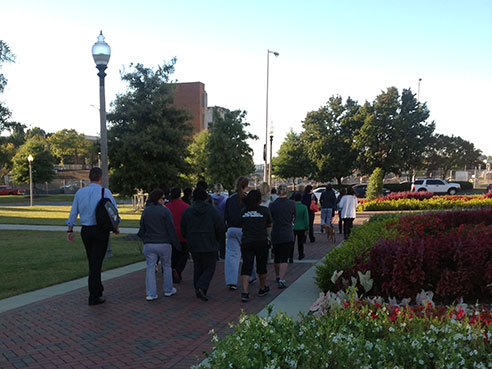 The first paper associated with UAB’s walking bus project was published in the Open Journal of Preventive Medicine. Co-authors Adrienne Milner, Ph.D., teaching assistant professor of sociology, and her colleague Assistant Professor Elizabeth Baker, Ph.D., led the campus effort.
The first paper associated with UAB’s walking bus project was published in the Open Journal of Preventive Medicine. Co-authors Adrienne Milner, Ph.D., teaching assistant professor of sociology, and her colleague Assistant Professor Elizabeth Baker, Ph.D., led the campus effort.In October, UAB kicked off the walking bus program for adults, the first of its kind. Just as with a traditional bus, there were fixed routes with designated stops and pickup times; but passengers walked instead of riding in a vehicle. Preselected participants joined in a study of their progress as they walked. The 51 pilot participants — the majority of whom are UAB employees or students and/or live within a 1.5-mile radius of the UAB campus green, Five Points South or Lakeview — were regularly monitored for blood pressure, weight and steps per day. The results of how walking affected their health were reported in the paper.
In “Motivations and barriers to utilizing adult walking buses: An examination of demographic correlates of willingness to participate in a community-based walking program,” the research outcome revealed that walking buses are “a likely viable option for increasing physical activity and decreasing obesity.” The most common barrier for participation, according to the study, was limited time among the participants. For that reason, the authors suggest that researchers should communicate how walking buses can save time rather than waste it, because it incorporates physical activity rather than forces the study participant to take additional time to exercise.
Milner and Baker’s project concept was among the winners of the inaugural Community Health Innovation Awards given by the One Great Community council of the University of Alabama at Birmingham Center for Clinical and Translational Science. They won the Health Disparities Research Award in adult obesity, sponsored by the UAB Minority Health and Health Disparities Research Center and Weight Watchers, Inc.